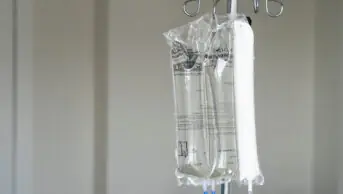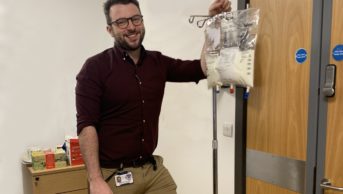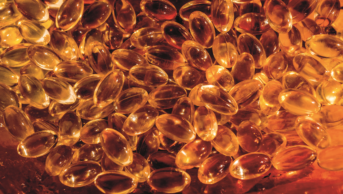This content was published in 2008. We do not recommend that you make any clinical decisions based on this information without first ensuring you have checked the latest guidance.
Drugs can interact with nutritional compounds, and their pharmacokinetics can be affected by a patient’s nutritional status. These effects can be clinically positive or negative and vary in significance.
The interrelationships between drugs and nutrients are complex, so there are many ways in which drugs and nutrients, or nutritional therapy, can interact[1].
For example:
- A nutrient may bind to a drug and reduce its, or the drug’s, absorption
- A drug may change the consistency of the feed formulation
- A nutrient may be involved in the metabolism of a drug, therefore promoting its clearance
- A nutrient’s excretion may be affected by a drug
Pharmacists should have a working knowledge of drug-nutrient interactions. This allows them to offer counselling on the optimum timing of drug administration around meals. Medicines used to treat HIV, or to prevent organ rejection after trans-plant, are particularly susceptible to nutrient interactions. The British National Formulary or summary of product characteristics should be consulted for individual preparations.
Direct absorption effects
There are many reported interactions between drugs and individual dietary components.
Nutrient absorption
Drugs can affect nutrient absorption. Antacids containing aluminium or magnesium hydroxide bind to dietary phosphate to form insoluble phosphate salts that cannot be absorbed. Osteomalacia has been reported as a result of phosphate depletion due to antacid abuse.
Tetracyclines
Tetracyclines readily chelate with divalent and trivalent metal cations (eg, calcium, magnesium, iron), for which there are higher concentrations in enteral feed and milk-based diets than normal diets. The chelated drug molecule changes in size and solubility, hence experiences reduced absorption from the gastrointestinal (GI) tract. Tetracycline absorption can be reduced by 80 per cent if it is co-administered with a nutritional feed. However, unlike other tetracyclines, doxycycline absorption is not affected by simultaneous ingestion of food and milk.
Macrolides
Ciprofloxacin absorption is decreased by 50 per cent if it is given with enteral feed. This is thought to be because drug molecules bind to divalent ions[2]. A similar reaction occurs with levofloxacin and ofloxacin, although it is less significant. There is no reaction with moxifloxacin. Ciprofloxacin also chelates with ions in tap or mineral water. However there is currently no research published on the significance of this interaction.
Protein binding
Reports of reduced absorption of phenytoin[3] and warfarin highlight the potential for a drug to bind to dietary protein in the GI tract, consequently reducing its absorption. There a recurrently no reports comparing the inter-action between these drugs and whole dietary protein, to that with the amino acids found in enteral feeds.
Pectin and fibre
Paracetamol absorption is reduced by pectin, which is present in apples and pears, although the significance of this interaction is unknown.
The absorption of digoxin is reduced if it is taken at the same time as fibre-rich foods[4]. The significance of this is negligible for patients who eat a healthy, balanced diet, but because digoxin has a narrow therapeutic index, its blood concentration should be closely monitored if a patient changes his or her fibre intake considerably (eg, from a high fibre normal diet to a low fibre enteral feed).
Indirect absorption effects
Most drugs are absorbed by passive diffusion from the gut lumen into the splanchnic circulation, across the GI mucosa. The rate of diffusion depends on contact time (between the drug and the mucosa) and the drug’s lipophilicity.
Delayed gastric emptying
Hot food and fatty meals delay gastric emptying to a greater extent than high protein or carbohydrate meals. This has two effects:
- It increases the time the drug spends in the stomach, which can increase drug disintegration and dissolution (and possibly degradation of acid-sensitive drugs)
- It delays the time taken for peak blood concentrations to occur for drugs absorbed from the small intestine
The combined effect usually increases the overall absorption of drugs, and the delay and reduction in peak plasma concentrations can be beneficial (eg, taking nifedipine with a meal delays and reduces the severity of the drug’s flushing side effect).
Increased hepatic bioavailability
The presence of food or enteral feed in the small intestine increases splanchnic blood flow. This may enhance drug absorption, and may also increase bioavailability, because blood flow through the portal system (to the liver)is reduced. This is the suggested mechanism by which concentrations of propranolol and metoprolol are higher if taken with food compared with when they are taken during a period of fasting[5].
Other GI effects
Bile salts, released in response to fat ingestion, may promote the absorption of highly lipid-soluble drugs, such as griseofulvin[6].
Drugs can reduce the absorptive capacity of the GI tract. For example, colchicine is associated with a malabsorptive diarrhoea, and long-term treatment with metformin is associated with vitamin B12 deficiency[7].
Some drugs cross the GI mucosa using active transport systems that are usually used to transport nutrients (eg, methyldopa and levodopa). The absorption of such drugs is decreased by a high protein diet[8].
Changes in feed consistency
Alterations in feed consistency are caused by a physical interaction between the drug and a component of the feed or the feed formulation — resulting in a physical change in the consistency of the feed. This can block an enteral feeding tube, or in extreme cases, result in physical obstruction of the GI tract.
The drug that has been most commonly reported to interact with enteral feed in this way is sucralfate. Adequate flushing between feeds and drug administration will minimise this effect. Drugs should never be added directly to a nutritional feed. Guidance for pharmacists dealing with enteral drug administration are be found in the British Pharmaceutical Nutrition Group handbook[9].
Metabolism interactions
Several foods can affect drug metabolism. The most well known is grapefruit juice, although interactions with pomegranate juice have become apparent more recently.
Grapefruit juice
Cytochrome P450 is a family of drug metabolising enzymes found predominantly in the small intestine and the liver. Grapefruit juice contains furanocoumarins, and other substances, that inhibit intestinal CYP3A, therefore reducing the metabolism of orally administered drugs. Intestinal drug transporters, such as p-glycoprotein, may also be inhibited.
Research has identified many drugs affected by this interaction. These drugs tend to have a low oral bioavailability, indicating significant presystemic metabolism in the intestine or the liver. Examples of drugs affected by this reaction include:
- Antibiotics (eg, erythromycin,albendazole, saquinavir)
- Cardiovascular drugs (eg, amiodarone,felodipine, verapamil)
- Phosphodiesterase type-5 inhibitors
- Immunosuppressants (eg, cyclosporin)
Pomegranate juice
The effect of pomegranate juice on drug metabolism is the subject of current research. It may affect CYP2C9[9], an enzyme also inhibited by fluconazole. It is possible that drugs whose metabolism is affected by fluconazole may also be affected by pomegranate juice. The clinical importance of this is not yet known.
Nutrient excretion
The most common group of drugs that affect nutrient excretion are the diuretics. Their ability to increase the excretion of electrolytes have been widely documented.
Other drugs that increase electrolyte excretion include amphotericin, and if cisplatin causes nephrotoxicity, this can increase the excretion of magnesium and zinc.
Pharmacist responsibilities
Pharmacists must have access to all the necessary information relating to:
- The drug and its formulation
- The patient’s condition
- The type of feeding tube, type of enteral feed and regimen being used
This information is used to recommend a suitable formulation for administration via a specified route. Pharmacists are responsible for informing the appropriate medical team if a drug is being administered by an unlicensed route.
When a drug formulation is changed, pharmacists must ensure that the dose of the new formulation is bioequivalent to the previous dose, to avoid treatment failure or toxicity.
In primary care, community pharmacists may not have access to information relating to the intended route of administration. Pharmacists supplying care homes should be aware of the route of administration for the medicines they supply. Information regarding drug administration via feeding tubes for care home patients should be communicated to the GP and community pharmacist when these patients are discharged from hospital. Every pharmacist has a role to play in minimising drug-nutrient interactions.
Information source
Pharmacists should ensure the nursing staff, patients and carers have enough information to give drugs safely. The provision of information by pharmacists on drug charts, in secondary care and nursing homes, is needed to prevent nursing staff from crushing tablets unnecessarily or administering inappropriate dosage forms.
In primary care, community pharmacists should discuss the most appropriate method of administration with the patient or carer and make sure he or she understands this information and is capable of administering each drug appropriately. Any problems identified should be discussed with the prescriber before the drugs are dispensed.
References
- White R, Ashworth A. How drug therapy can affect, threaten and compromise nutritional status. Journal of Human Nutrition and Dietetics 2000;13:119–29.
- Cohn SM, Sawyer MD, Burns GA, Tolomeo C, Milner KA. Enteric absorption of ciprofloxacin during tube feeding in the critically ill. The Journal ofAntimicrobial Chemotherapy 1996;38:871–6.
- Bauer IA. Interference of oral phenytoin absorption by continuous nasogastric feeding. Neurology1982;32:570–5.
- Johnson BF, Rodin SM, Hoch K, Shekar V. The effect of dietary fiber on the bioavailability of digoxin in capsules. Journal of Clinical Pharmacology 1987;27:487–90.
- Melander A, Danielson K, Scherstein B, Wahlin E.Enhancement of the bioavailability of propranolol and metoprolol by food. Clinical Pharmacology andTherapeutics 1977;22:108.
- Welling PG. Influence of food and diet on gastrointestinal drug absorption: a review. Journal of pharmacokinetics and biopharmaceutics1977;5:291–333.
- Adam JF, Clark JS, Ireland JT, Kesson CM, WatsonWS. Malabsorption of vitamin B12 and intrinsic factor secretion during biguanide therapy. Diabetologia 1983;24:16–8.
- Gillespie NG, Mena I, Cotzias GC, Bell MA. Diets affecting treatment of parkinsonism with levodopa.Journal of the American Dietetic Association1973;62:525.
- White R, Bradnam V. Handbook of drug administration via enteral feeding tubes.Pharmaceutical Press: London; 2007.


